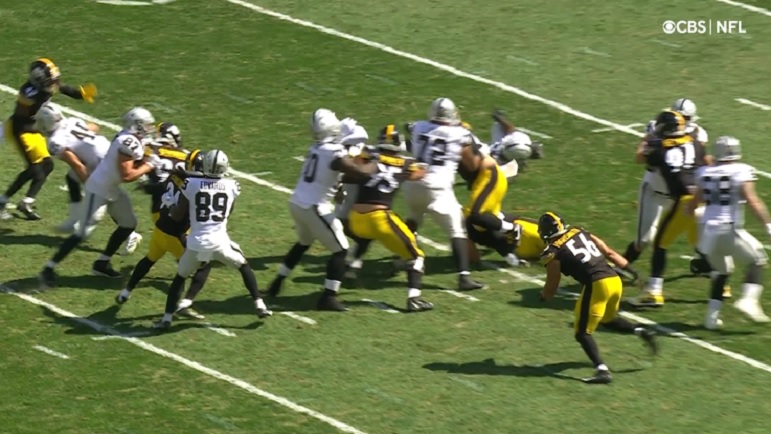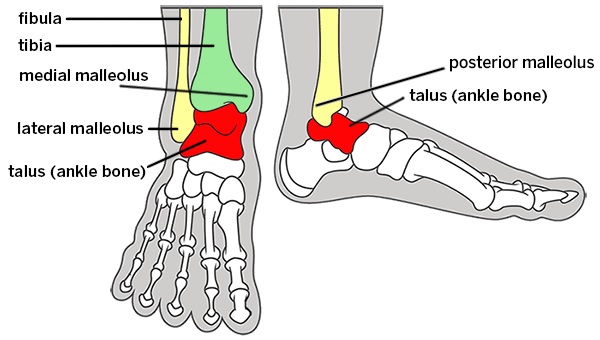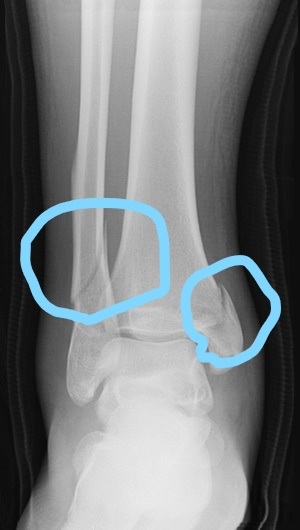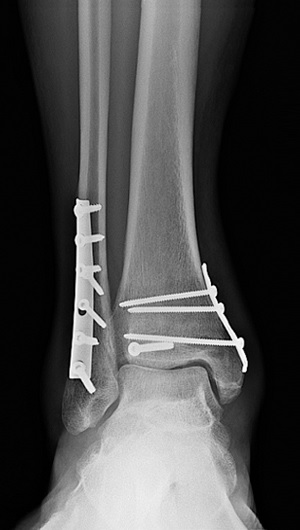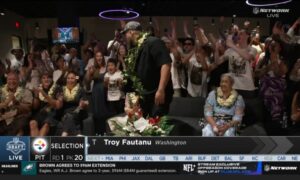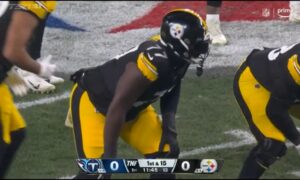It was a brutal day for injuries as the Steelers lost their Week 2 match against the Las Vegas Raiders. The most significant loss appears to have occurred in the first quarter, as defensive tackle Tyson Alualu suffered an ankle injury which was later clarified to be an ankle fracture. In his post-game press conference Head Coach Mike Tomlin stated that Alualu would “be out for extended time”. After the game, Gerry Dulac reported that surgery would happen tomorrow and Alualu was expected to miss the rest of the season:
Let’s start with the basic anatomy. The ankle joint is made of three bones which connect the lower leg to the foot, the tibia and fibula (the lower leg bones) and the talus. The fibula and tibia each has a portion of bone at the lower aspect that extends over the side of the talus, the medial and lateral malleolus. The bones are held together by ligaments.
Figure 1 HSS.edu
OK, now for some info on ankle fractures. The Hospital for Special Surgery in NY explains it nicely:
What are the different types of ankle fractures?
Because the ankle joint comprises three bones, there are numerous types of ankle fractures. Doctors think of the ankle as having three sides and a “roof,” and fractures can occur in each of these areas or in combination.
The lower portion of the tibia forms the roof and medial (inside) of the ankle, while the lower portion of the fibula forms the lateral (outside) and posterior (back) of the ankle.
Most common ankle fractures
- Lateral malleolus fracture: This is the most common type of ankle fracture. It is a break of the lateral malleolus, the knobby bump on the outside of the ankle (in the lower portion of the fibula).
- Bimalleolar ankle fracture: This second-most common type involves breaks of both the lateral malleolus and of the medial malleolus, the knobby bump on the inside of the ankle (in the lower portion of the tibia).
- Trimalleolar ankle fracture: This type involves breaks in three sides of the ankle: the medial malleolus of the tibia, as well as the lateral malleolus and posterior malleolus (in the lower portion of the fibula).
- Pilon fracture (also called a plafond fracture): This is a fracture through the weightbearing “roof” of the ankle (the central portion of the lower tibia). This is usually a higher energy traumatic injury resulting from a fall from a height.
As the number of fracture lines increase, so does the risk of long-term joint damage. Trimalleolar ankle fractures and pilon fractures have the most cartilage injury and, therefore, have a higher risk of arthritis in the future.
Nondisplaced vs. displaced ankle fractures
Within each of the above types, the fracture will be either:
- Nondisplaced – Bones are broken but still in correct position and alignment.
- Displaced – Fractured portions of bone are separated or misaligned. The treatment will be based on fracture alignment and stability of the ankle.
One other important consideration is the compound fracture, where the broken edge of the bone tears the skin, resulting in a very risk for infection. Compound, or open, fractures always require emergency surgery. There are some additional, unique types of fractures. We’ll skip those for now.
While an MRI can provide detailed information about any associated ligament damage, an ankle fracture can be diagnosed by a regular Xray. I circled the two fractures here in the distal fibula and tibia:
Figure 2 HSS.edu
Here’s an example of repair of that bimalleolar fracture:
An isolated fibula fracture doesn’t always require surgery because if the tibia is not injured, the ankle joint may not have any instability. This was the case with cornerback Joe Haden back in 2017. He missed seven weeks (six games and a bye week). It doesn’t always go that way. I’m sure Steelers fans remember that a preseason fibula fracture required seven surgeries and kept Center Maurkice Pouncey the entire 2015 season. But that was an open fracture and he suffered a very significant infection which required removal of the hardware used to fix the fracture.
It typically takes the bones 6 weeks to heal following surgery. If there are ligament injuries, the recovery can take longer. A review of the NFL database from 2000-2014 of distal fibula fractures identified 237 distal fibula fractures and 83% were isolated (i.e., no other fractures).
- 54% of players underwent surgery
- The mean return to play for those who had surgery was 124 days
- The mean return to play for those who didn’t require surgery was 75 days
What about more complicated fractures? A review of 488 patients ranging from recreational to competitive athletes with unstable ankle fractures found the following:
- Unsurprisingly, there was a higher rate of return to sport for the recreational athletes, which is less demanding physically
- At 12 months, bimalleolar injuries were more likely to return to sports than unimalleolar ankle fractures
- Patients without an associated ligament injury between the fibula and tibia were more likely to return to athletic activities at 12 months
- Predictors of return to sporting activities at one year include younger age, male gender, no or mild systemic disease, and a less severe ankle fracture.
So what about Alualu?
OK, speculation time. [And the usual disclaimer that I haven’t examined the player or his medical records]
He was reportedly wearing an air cast on his ankle when he was carted to the locker room. That suggests that the team medical staff was concerned that there was a loss of ankle stability, but it could have just been a precaution. If he does have an unstable ankle fracture involving multiple bones, obviously that would suggest a longer recovery time. His age and health work in his favor, though, and he will have access to exceptional medical care throughout his surgery and rehab. So he could be at the shorter end or recovery times predicted by the studies I shared.
Given that he won’t be undergoing surgery until tomorrow, we can assume that he doesn’t have an open, or compound, fracture, which is very good news and means he isn’t at increased risk for infection. He posted a photo from the hospital on his IG this evening that shows his leg in a splint:
Since we don’t know the details of the type of fracture, I would suggest it’s too soon to say that Alualu can’t make it back this season. It will certainly depend on multiple factors: his recovery, the depth at his position and the team’s playoff chances. But it’s too soon to rule out a return. He signed a two-year contract prior to the season, so let’s hope he can make it back before the end of the season and return for 2022.
“Melanie H. Friedlander, M.D., F.A.C.S. is a doctor at Association of South Bay Surgeons in Torrance, California. Dr. Friedlander enjoys all aspects of general surgery, but her primary areas of focus are breast surgery and advanced laparoscopic surgery. She recently adopted an advanced, minimally invasive technique that reduces scar size in thyroid surgery. Dr. Friedlander is a member of the Society of American Gastrointestinal Endoscopic Surgeons (SAGES) and the Society of Laparoscopic Surgeons. She developed and published many scientific studies in highly esteemed medical journals.”

